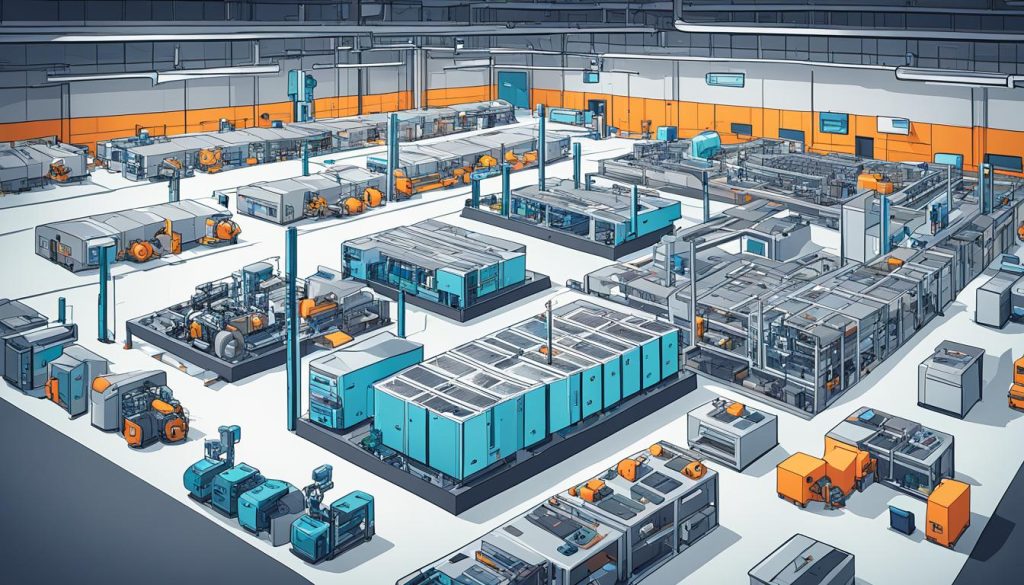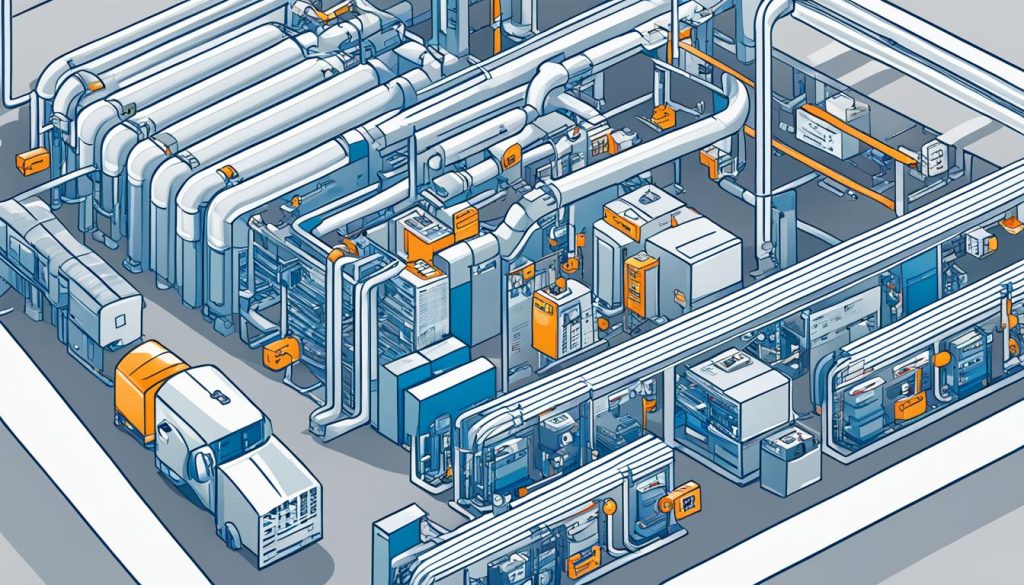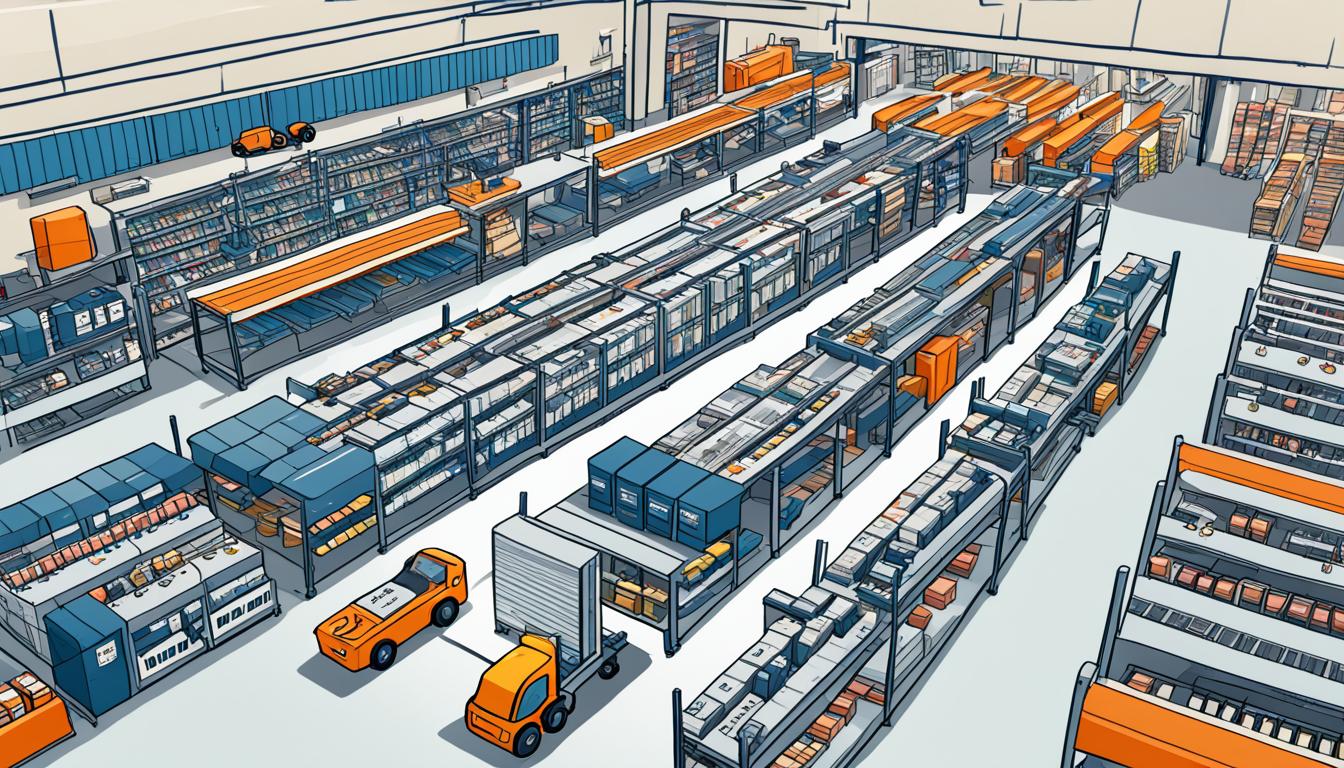To make your HVAC inventory management better, use smart systems for tracking and reordering parts. This makes your daily work easier, cuts costs, and increases your revenue.
Keeping your HVAC inventory in check is crucial for smooth operations. Automating your parts tracking gives you real-time updates on stock levels. This helps you make better decisions and manage your cash flow better.
Using reordering systems takes your inventory to the next level. These tools automatically order parts when you’re running low. This means you always have what you need, reducing downtime and making customers happier with faster repairs and installations.
Automated solutions for HVAC inventory management set your business up for success. They make your operations smoother and give you important data to predict demand and improve your inventory even more.
Understanding the Importance of HVAC Inventory Management
Managing your HVAC inventory well is key to your business doing great. It affects how you run your day, your costs, and how happy your customers are. Using strong HVAC parts inventory tracking systems helps you manage your supply chain better and boosts your performance.
Impact on Daily Business Operations
Good inventory control means you always know what parts and equipment you have. This makes sure your technicians have what they need for each job, cutting down on delays and making them work better. With real-time tracking, finding items is easy and you can avoid running out of stock, which could mess up your plans.
Cost and Revenue Implications
Managing your HVAC inventory well can really help your profits. By keeping the right amount of stock, you cut down on storage costs and avoid having old inventory. Also, optimizing your supply chain lets you find ways to save money and get better deals from suppliers.
| Cost Factor | Impact of Effective Inventory Management |
|---|---|
| Carrying Costs | Reduced by 20-30% |
| Stockouts | Decreased by up to 50% |
| Obsolete Inventory | Minimized by 15-25% |
Customer Satisfaction and Service Efficiency
Having the right parts when you arrive at a job makes customers happy and your service better. Your technicians can fix things quicker, which means less downtime for your customers. This reliability builds trust and can get you more referrals and repeat customers.
Regular checks on your inventory can uncover shrinkage and help you keep the right amount of stock. By using advanced inventory systems, you can keep up with trends like more eco-friendly appliances. This lets you adjust your inventory and meet market needs.
Common Challenges in HVAC Parts Tracking
HVAC supply chain challenges can really disrupt your business. You might struggle with keeping track of your inventory and managing stock. Let’s look at some common issues you might face when tracking HVAC parts.
Finding stock quickly becomes hard when your tracking system doesn’t work well. This means you spend a lot of time looking for parts. It leads to delays in finishing jobs and unhappy customers. Ordering too much inventory uses up your money, while ordering too little means you run out and miss sales.
Not having all your data in one place makes things worse. Without a single system, you’re stuck with many spreadsheets or old paper records. This makes it easy to make mistakes and keep track of inventory inaccurately.
- Inefficient manual tracking systems
- Time-consuming stock checks
- Inaccurate inventory counts
- Difficulty managing multiple locations
- Poor visibility of parts in fleet vehicles
Knowing what parts you have and where they are in real-time is another big challenge. You need to see what’s available and where at all times. Without this info, you might send techs to jobs unprepared or buy parts you already have.
| Challenge | Impact | Solution |
|---|---|---|
| Inability to locate stock | Delayed jobs, customer dissatisfaction | Implement barcode scanning system |
| Over/under-ordering | Wasted money, missed sales | Use automated reordering based on usage data |
| Lack of centralized data | Errors, inefficiencies | Adopt cloud-based inventory management software |
| Poor multi-location visibility | Inefficient resource allocation | Implement real-time tracking across all locations |
To tackle these HVAC supply chain challenges, you need a good plan for managing your inventory. With the right tools and processes, you can beat these problems and make your operations smoother.
Implement Automated Parts Tracking for Optimal HVAC Inventory Management
Automated parts tracking can change how you manage HVAC inventory. Using HVAC parts management software makes operations smoother and more efficient. Let’s look at the benefits, key features, and steps to use automated inventory control systems.
Benefits of Automated Tracking Systems
Automated inventory control systems bring big advantages to HVAC businesses:
- Improved accuracy in stock levels
- Reduced manual errors
- Time savings on inventory counts
- Better forecasting capabilities
- Enhanced customer service
Key Features to Look for in Automated Solutions
When picking HVAC parts management software, look for these key features:
| Feature | Description | Benefit |
|---|---|---|
| Barcode scanning | Quick and accurate part identification | Speeds up inventory processes |
| Real-time inventory tracking | Up-to-date stock information | Prevents stockouts and overordering |
| Multi-location support | Manages inventory across various sites | Improves overall stock visibility |
| Integration capabilities | Connects with existing business systems | Streamlines workflows and data sharing |
Implementation Steps and Best Practices
Here are the steps to put automated parts tracking into action:
- Assess your current inventory management needs
- Research and select suitable HVAC parts management software
- Plan the implementation timeline
- Train staff on the new system
- Gradually transition from manual to automated processes
Best practices include regularly updating your system, providing ongoing training, and using real-time inventory tracking. This keeps stock levels optimal.
By using automated inventory control systems, you’ll have better control over your HVAC parts. This leads to improved efficiency and customer satisfaction.
Leveraging Real-Time Inventory Visibility
Real-time inventory visibility changes how you manage HVAC stock. With inventory tracking technology, you get instant updates on your parts and equipment. This tool helps you make quick decisions and work more efficiently.
- Minimize stockouts
- Reduce excess inventory
- Improve cash flow
- Enhance customer satisfaction
Barcode scanning and mobile apps are key to real-time inventory visibility. They make it easy and fast to update your inventory. This ensures your HVAC stock management is always up-to-date.
Real-time tracking gives you insights into what you buy and use. By looking at this data, you can adjust your stock levels. This helps you know when to order more parts.
| Benefits | Impact on HVAC Business |
|---|---|
| Accurate stock counts | Reduced carrying costs |
| Faster order fulfillment | Improved customer satisfaction |
| Proactive inventory management | Fewer emergency orders |
Using real-time inventory visibility puts your HVAC business on the right track. This tech lets you make smart choices, improve your workflow, and meet customer needs better.
Streamlining the Reordering Process
Having a smooth reordering process is key to managing HVAC inventory well. Using automated systems helps make sure you always have the parts you need. This way, you don’t waste money on too much inventory.
Setting Up Automated Reordering Workflows
Automated workflows start ordering when you’re running low on parts. This keeps your inventory steady and avoids having too much stock. Here’s how to set it up:
- Analyze historical usage data to determine optimal reorder points
- Configure your inventory management software with these thresholds
- Set up automatic purchase orders to vendors when levels drop
Optimizing Vendor Relationships
Good vendor management is key for smooth operations. Use special software to track how well vendors perform, negotiate better prices, and get better delivery terms. Regular talks and reviews can make your partnerships stronger and better for your business.
Balancing Stock Levels and Cash Flow
Managing inventory and cash flow well is tricky. You want enough stock but not too much. Here are some tips:
- Implementing just-in-time inventory practices
- Negotiating consignment agreements with trusted suppliers
- Utilizing data analytics to predict seasonal demand fluctuations
Mastering these parts of reordering will make your HVAC operations more efficient and profitable.
Integrating IoT and Smart Warehouse Management
IoT in HVAC inventory changes how you manage your warehouse. It uses smart sensors and devices to give you real-time info on stock, equipment, and usage. This lets you make smart choices, cut waste, and boost efficiency.

- Automated stock tracking
- Optimized storage layouts
- Efficient picking and packing processes
- Predictive maintenance alerts
- Enhanced inventory accuracy
Connected inventory systems link your warehouse to your supply chain. This creates a smooth flow of information. It helps you work better with suppliers, meet customer needs faster, and run more efficiently.
| Traditional Inventory Management | IoT-Enabled Inventory Management |
|---|---|
| Manual stock counts | Real-time inventory tracking |
| Reactive maintenance | Predictive maintenance |
| Fixed reorder points | Dynamic reordering based on usage patterns |
| Limited visibility | Complete supply chain transparency |
By using IoT and smart warehouse tech, you turn your HVAC inventory into a proactive, data-driven system. This not only makes things run smoother but also helps you grow and make customers happier.
Utilizing Data Analytics for Inventory Optimization
Data analytics changes how we manage HVAC inventory. It lets you adjust stock levels and improve efficiency. This new way changes how you handle parts and equipment.
Demand Forecasting and Trend Analysis
Demand forecasting predicts what you’ll need in the future. By looking at past data, you can see busy and slow times. This helps you stock up on important parts when it’s needed and avoid overstocking.
Performance Metrics and KPIs
Inventory KPIs are key to checking how well you’re doing. Keep an eye on things like inventory turnover ratio, stockout rate, and carrying costs. These numbers show where you can get better and help you make smart choices.
| KPI | Description | Target Range |
|---|---|---|
| Inventory Turnover Ratio | How often inventory is sold and replaced | 4-6 times per year |
| Stockout Rate | Percentage of items out of stock | <2% |
| Carrying Costs | Expenses for storing inventory | 15-25% of inventory value |
Continuous Improvement Strategies
Always look for ways to get better at managing your inventory. Check your data often and tweak your plans. This keeps your HVAC business competitive and efficient in a changing market.
Ensuring Seamless Integration with Existing HVAC Business Processes
Adding automated inventory systems to your HVAC business is key to making things run smoother. A good plan for integrating your HVAC business processes can make managing inventory better and increase efficiency.
First, look at your current processes to see where automation can help. Think about areas like managing work orders, scheduling, and accounting. This will help you pick a solution that fits your needs.

When picking new inventory management systems, keep these things in mind:
- Compatibility with existing software
- Mobile accessibility for field technicians
- User-friendly interfaces for easy adoption
- Scalability to accommodate future growth
Integrate new systems step by step to avoid disrupting your work. Begin with a small group or location before expanding. This way, you can spot and fix problems early.
Training is key for success. Make sure your team knows how to use the new system well. This will lead to better efficiency and fewer mistakes.
| Integration Step | Benefit |
|---|---|
| Work Order Integration | Streamlined job tracking and parts allocation |
| Accounting System Connection | Accurate financial reporting and forecasting |
| Mobile App Integration | Real-time inventory updates from the field |
| Customer Portal Integration | Enhanced service transparency and satisfaction |
By focusing on smooth integration, you’ll have a more efficient HVAC business. It will use automation’s power while keeping your current workflows strong.
Conclusion: Transforming HVAC Operations through Automated Inventory Management
Automated parts tracking and reordering systems are changing the game for HVAC businesses. They help you transform your operations and bring many benefits. These tools make your daily work smoother and more efficient.
One big plus is better cash flow management. With real-time inventory views, you can manage stock levels and buy what you need. This means less waste, fewer stockouts, and smarter use of your money. Your technicians will have more time to help customers, making them happier and more productive.
The benefits don’t stop at just saving money. They also help you build better customer relationships, stay ahead in the market, and keep making profits. While starting these systems takes planning and some money upfront, the long-term gains in efficiency and growth are worth it. It’s a smart choice for HVAC companies looking to the future.





0 Comments